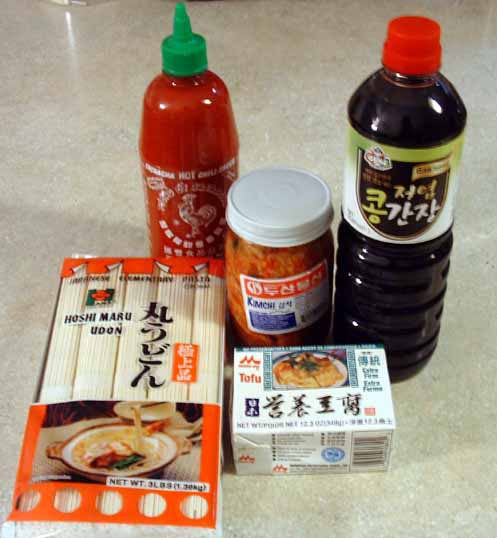On Sundays I try to make up some lunches to pack up so I can take them to work the next week, something I can nuke, and save a smidgen of money over eating lunch out. Inspired by the Kimchee Fries I had from the SsahmBBQ Food Truck I decided to do something with Kimchi. Instead of fries, I thought I’d have them with Tofu and Udon noodles (I love the big, pfat udon).
Low on raw materials, I headed out to Saigon Mall, the Asian grocery store (and more) near our house. I go there a lot – though not as often as I’d like. It’s like taking a little exotic vacation for the cost of a meal, smoothie, or a bag of groceries.
I was low on Udon, so I bought a package. Saigon Mall has two entire aisles plus a refrigerated section dedicated to noodles in all their varied glory. I’ve tried several brands, and decided that I like the Hoshi Maru Udon the best.
When you buy noodles from Saigon Mall the receipt always says “Alimentary Paste” on it. I thought that was some sort of mistranslation until I did a tiny bit of research where I discovered that this was something our government, in all its wisdom, required.
From the Cook’s Thesaurus at foodsubs.com
Asian noodles Notes: Until recently, the U.S. government required a noodle to contain flour, water, and eggs to be rightly called a noodle. Since most Asian noodles aren’t made with eggs, this left them without much of an identity. The FDA permitted names like “alimentary paste” and “imitation noodles,” but Asian noodle producers–from the birthplace of the noodle no less–could not use the n-word. The government finally relented, and we can now use the name “Asian noodles.”
The Hosi Maru Udon package has the words “Elementary Pasta” written on it. I’m not sure if that is a derivative of “alimentary paste” or not. Luckily I’ve never seen it transposed as “Elementary Paste” – that sounds like what we all ate in third grade.
They had ready-made Kimchi in refrigerated glass bottles. The small quart size said “Kimchi” on it… the big gallons said “MocKimchi.” I don’t know if there is a difference, but as far as I could see the stuff in the jar looked identical. I’m not quite up to buying the gallon size jar of fermented cabbage yet, so I stuck with the quart.
The store has a mind-boggling selection of sauces. I chose an inexpensive soy sauce pretty much at random and bought a big bottle of Sriracha brand Rooster sauce. A package of firm tofu… and I had my raw ingredients.
I sautéed slices of the tofu in a pan until they were a little brown, then cooked some soy sauce with them until it reduced. Meanwhile, I boiled up a mess of udon.
I opened the jar of Kimchi and watched the spicy, fermented cabbage bubble and burp (I guess this is how you know it’s good kimchi) before I dumped it out.
When all this was done, I divided it all up into four meals, then squirted Sriracha over the noodles for flavor and kick.
They are packaged apart, but I’ll eat it all together, mixed in a bowl. A pretty good lunch, actually.
Now, there is one problem. All you purists will look at this and say, “You’ve got Japanese Udon, Korean Kimchi, hot sauce that’s a mixture of Thai, Vietnamese, and Chinese flavors though it’s made in America and manipulated for Western Tastes. You don’t know what the hell you are doing… mixing all these foods together like that. That is not how these ingredients are supposed to be prepared and served. You are showing your ignorance and disrespect for the culinary cultures of a billion people and look like an idiot for doing so.”
And that is all true. I don’t know what I’m doing and I am an idiot. Thinking about this for a while, I realized there is only one possible riposte to this criticism, “I like it, if you have a problem, you can go fuck yourself.”




I take it that you like Korean food like I do. Its amazing stuff!
Pingback: Super H Mart | Bill Chance
I just paid $20.00 for the gallon Mockimchi, thinking it was a hulluva deal compared to the $13.00 I pay for a pint at Vitimin Cottage.
Got it ot to eat tonight, then….read the label….
MSG, saccarin(wasn’t that stuff banned in th ’60’s?) and artificial sweetners.
Ugh! I ventured into Kimchi land for the probiotics and healthy aspects of it only to find I blew $20.00 on toxic waste. I knew those ladies at the market woldn’t let me return it, so into the dumper it went.
At least I got a big glass jar to make my own out of the deal….